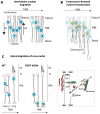Nuclear envelope: positioning nuclei and organizing synapses
- PMID: 26079712
- PMCID: PMC4522371
- DOI: 10.1016/j.ceb.2015.06.001
Nuclear envelope: positioning nuclei and organizing synapses
Abstract
The nuclear envelope plays an essential role in nuclear positioning within cells and tissues. This review highlights advances in understanding the mechanisms of nuclear positioning during skeletal muscle and central nervous system development. New findings, particularly about A-type lamins and Nesprin1, may link nuclear envelope integrity to synaptic integrity. Thus synaptic defects, rather than nuclear mispositioning, may underlie human pathologies associated with mutations of nuclear envelope proteins.
Copyright © 2015 Elsevier Ltd. All rights reserved.
Conflict of interest statement
The authors declare no competing financial interests.
Figures



References
-
- Malone CJ, Fixsen WD, Horvitz HR, Han M. UNC-84 localizes to the nuclear envelope and is required for nuclear migration and anchoring during C. elegans development. Development. 1999;126:3171–3181. - PubMed
-
- Starr DA, Hermann GJ, Malone CJ, Fixsen W, Priess JR, Horvitz HR, Han M. unc-83 encodes a novel component of the nuclear envelope and is essential for proper nuclear migration. Development. 2001;128:5039–5050. - PubMed
-
- Starr DA, Han M. Role of ANC-1 in tethering nuclei to the actin cytoskeleton. Science. 2002;298:406–409. - PubMed
-
- Burke B, Stewart CL. The nuclear lamins: flexibility in function. Nat Rev Mol Cell Biol. 2013;14:13–24. - PubMed
Publication types
MeSH terms
Substances
Grants and funding
LinkOut - more resources
Full Text Sources
Other Literature Sources

